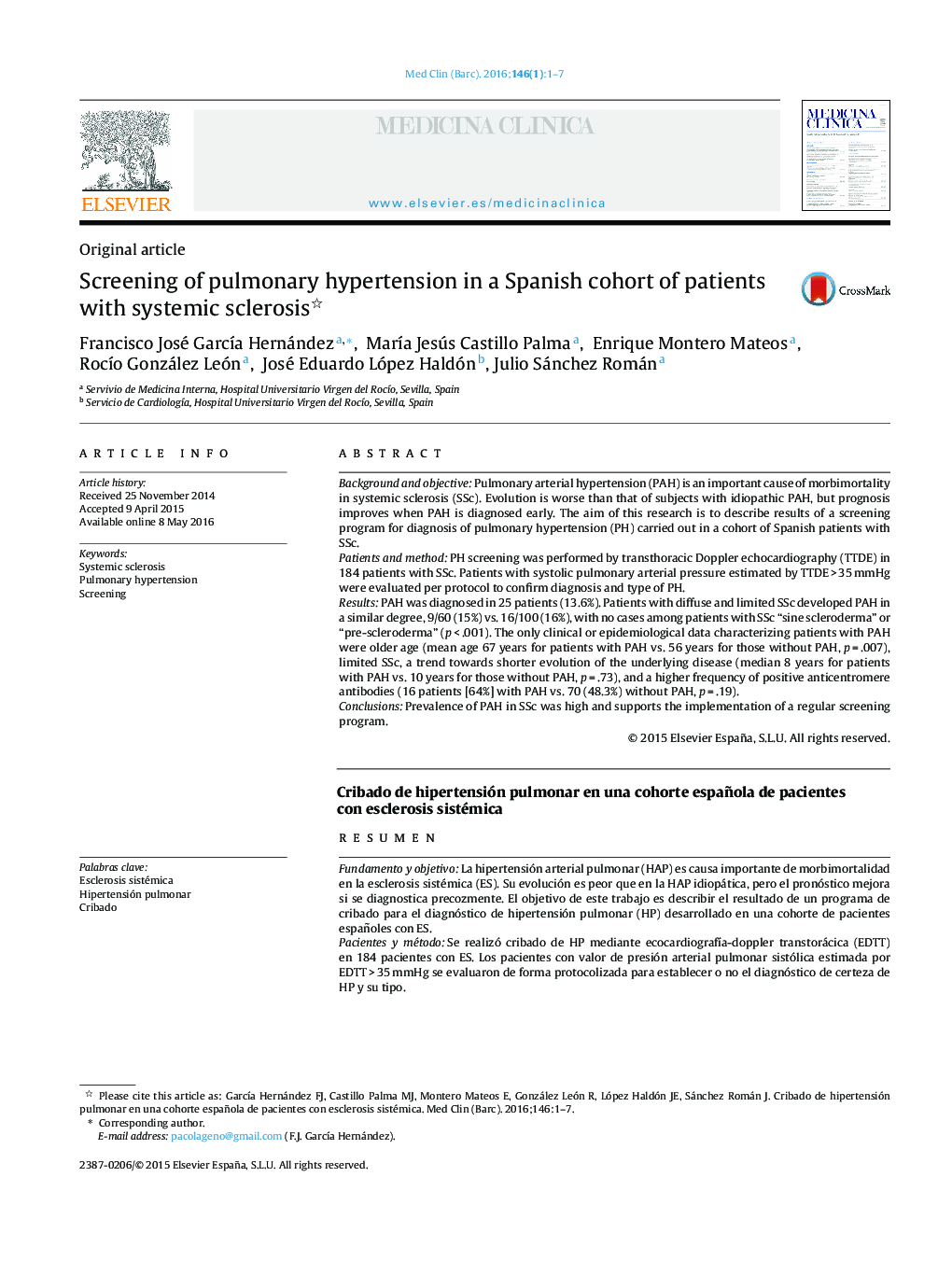| کد مقاله | کد نشریه | سال انتشار | مقاله انگلیسی | نسخه تمام متن |
|---|---|---|---|---|
| 3805509 | 1245190 | 2016 | 7 صفحه PDF | دانلود رایگان |

Background and objectivePulmonary arterial hypertension (PAH) is an important cause of morbimortality in systemic sclerosis (SSc). Evolution is worse than that of subjects with idiopathic PAH, but prognosis improves when PAH is diagnosed early. The aim of this research is to describe results of a screening program for diagnosis of pulmonary hypertension (PH) carried out in a cohort of Spanish patients with SSc.Patients and methodPH screening was performed by transthoracic Doppler echocardiography (TTDE) in 184 patients with SSc. Patients with systolic pulmonary arterial pressure estimated by TTDE > 35 mmHg were evaluated per protocol to confirm diagnosis and type of PH.ResultsPAH was diagnosed in 25 patients (13.6%). Patients with diffuse and limited SSc developed PAH in a similar degree, 9/60 (15%) vs. 16/100 (16%), with no cases among patients with SSc “sine scleroderma” or “pre-scleroderma” (p < .001). The only clinical or epidemiological data characterizing patients with PAH were older age (mean age 67 years for patients with PAH vs. 56 years for those without PAH, p = .007), limited SSc, a trend towards shorter evolution of the underlying disease (median 8 years for patients with PAH vs. 10 years for those without PAH, p = .73), and a higher frequency of positive anticentromere antibodies (16 patients [64%] with PAH vs. 70 (48.3%) without PAH, p = .19).ConclusionsPrevalence of PAH in SSc was high and supports the implementation of a regular screening program.
ResumenFundamento y objetivoLa hipertensión arterial pulmonar (HAP) es causa importante de morbimortalidad en la esclerosis sistémica (ES). Su evolución es peor que en la HAP idiopática, pero el pronóstico mejora si se diagnostica precozmente. El objetivo de este trabajo es describir el resultado de un programa de cribado para el diagnóstico de hipertensión pulmonar (HP) desarrollado en una cohorte de pacientes españoles con ES.Pacientes y métodoSe realizó cribado de HP mediante ecocardiografía-doppler transtorácica (EDTT) en 184 pacientes con ES. Los pacientes con valor de presión arterial pulmonar sistólica estimada por EDTT > 35 mmHg se evaluaron de forma protocolizada para establecer o no el diagnóstico de certeza de HP y su tipo.ResultadosSe diagnosticó HAP en 25 pacientes (13,6%). Los pacientes con ES difusa y limitada desarrollaron HAP en proporciones semejantes: 9 de 60 (15%) frente a 16 de 100 (16%). No se registraron casos entre pacientes con ES «sine esclerodermia» o «preesclerodermia» (p < 0,001). Los únicos datos clinicoepidemiológicos que caracterizaron a los pacientes con HAP fueron una edad más avanzada (edad media de 67 años para pacientes con HAP frente a 56 años sin HAP, p = 0,007), especialmente relacionada con la ES limitada, y una tendencia hacia un menor tiempo de evolución de la enfermedad de base (mediana de 8 años para pacientes con HAP frente a 10 años sin HAP, p = 0,73) y una mayor frecuencia de positividad para anticuerpos anticentrómero: 16 (64%) pacientes con HAP frente a 70 (48,3%) sin HAP (p = 0,19).ConclusionesLa prevalencia de HAP en ES resultó elevada y apoya la implantación de programas de cribado sistemático.
Journal: Medicina Clínica (English Edition) - Volume 146, Issue 1, 1 January 2016, Pages 1–7